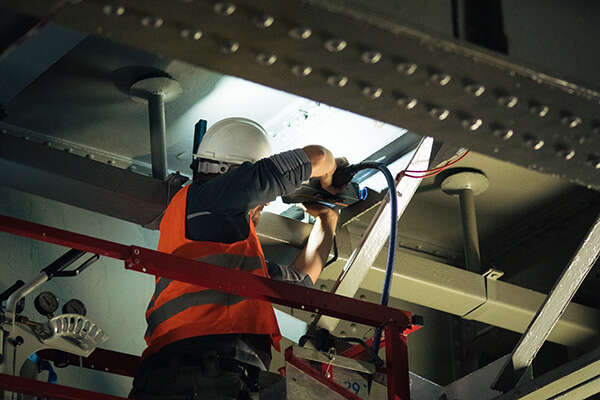When measuring historic steels in infrastructure like bridges, it isn’t always easy to get steel input values for component safety calculations. Quite often destructive testing is used, where a sample is taken from a structure, causing damage that must be repaired. This can also be difficult, time-consuming, and expensive.
To measure historic old steels at the Berlin East train station and develop new guidelines for component safety in the German construction industry, engineering consulting company, IWT Solutions AG turned to Hitachi’s PMI-MASTER Smart portable spark OES analyzer for non-destructive on-site elemental analysis to complete the necessary steel input calculations.

Berlin East Station was built in the 19th century and uses a lot of historic old steels. Preliminary investigations showed that different steels were used – in this case puddle steel and mild steel – which have fundamentally different chemical compositions. And thus, impact component safety and why PMI inspection was vital.
IWT Solutions AG has been working on a project with Professor Bertram Kühn from the Department of Steel, Composite and Timber Construction at the Technische Hochschule Mittelhessen to investigate component safety and to develop a new method that makes the whole process of measuring material properties easier, faster, and more efficient.
With the help and support of Deutche Bahn AG (German Rail), a total of thirty drill cores were extracted and first analyzed in the laboratory. They were also tested for coating composition and how deep to grind to establish chemical composition.
Until now, only laboratory-based equipment was used to deliver the compositional metal analysis to provide the values needed for calculations. The team knew that using OES has its strengths in the laboratory. But onsite, the team works in different conditions. That’s why portable OES was chosen to determine the chemical composition of the bridge structure.
Using XRF, X-ray fluorescence analysis, was also recommended and considered. Portable XRF is easy to use but OES was ultimately chosen as measuring carbon is an important part of the measuring task, which XRF instruments can’t do.
The team at IWT Solutions AG visited Hitachi’s application center in Germany for in-house investigations. This enabled further testing to be carried out with the PMI-MASTER Smart to see whether the fundamental elements could also be identified by mobile spark OES. With test results confirmed to IWT Solution AG’s satisfaction, it was time to take a portable metals analyzer on-site.
Hitachi’s experts joined IWT Solutions AG to see how to adapt what is done in the laboratory on-site.
Peter Langenberg, owner and CEO of IWT Solutions AG, commented “We hope to learn a lot more about the bridge and faster, as taking samples how we used to would limit our sample numbers. We expect with the PMI-MASTER Smart to take 100 or 200 measurements in relatively short time.”
The chemical elements of interest for this project are those typical for structural steel such as carbon, manganese, silicon, phosphorus, and sulfur. In preliminary investigations the team found that phosphorous is a very important element to help distinguish between steels, namely between puddle steel and mild steel.
With phosphorus being intrinsically bad for steel and not easy to measure, the team found that with Hitachi’s UVTouch probe, it couldn’t be easier to measure phosphorus and sulfur.
Watch Professor Langenberg talk about why they chose the PMI-MASTER Smart
The construction industry relies heavily on standards and guidelines and Deutsche Bahn AG has many of their own guidelines in addition to the known standards. The recalculation guideline 805 applies specifically to old steel, to old structures.
Peter Langenberg, owner and CEO of IWT Solutions AG, commented: “If this test is successful, we hope to include this process in the recalculation guideline as a minimally invasive measurement method and provide a broad group of users with the possibility of applying this process. Our next steps are to see if everything works out as planned. So far it looks very positive.”
The plan is then to turn this into a guideline on how to safely apply the process, giving out specifications for third parties who apply this process, so they know what to do without having to repeat the developments. Based on the guideline they know exactly what to do to get a safe result. After all, the result will affect component safety and structure.
The team from IWT Solutions AG not only came across a very compact, easily portable instrument from Hitachi but received significant support throughout the project. First during the trial measurements and also with the onsite measurements carried out in Berlin.
Peter Langenberg, owner and CEO of IWT Solutions AG, summarized: “Good support to us means that while we have defined the measurement task, we don’t fully understand how the instrument works, so when there are specific issues we have experts ready to help us. They are able to tell us how we can best adjust the analyzer for the task. This way we can combine using the analyzer and taking the measurement correctly.
“Having spent two days measuring with the analyzer, and of course I received a good introduction at Hitachi’s application center, my team and I have found that we were able to operate the PMI-MASTER Smart relatively quickly on our own. We understood the display, how to set-up the instrument, and all the functions are self-explanatory. I must compliment the device; it’s very well built.”
If you’d like to find out how our different solutions could help you with PMI safety inspection or component safety analysis, contact our experts for a demo.
Get in touch
You might also be interested in: